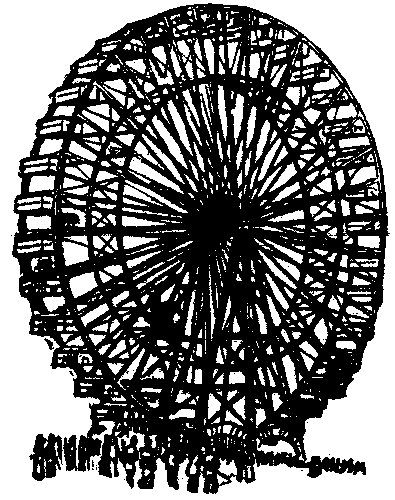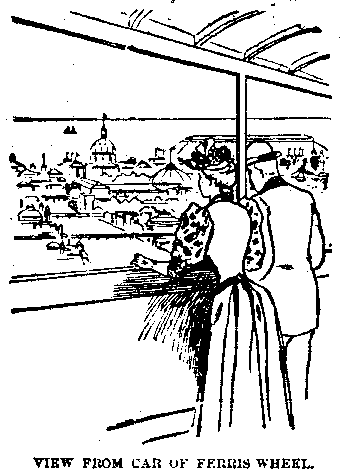

It Is the Chief Sensation of the World's Fair.
Inventor Declared a Genius.
When He First Broached His Plans to the Directors of the World's Fair
They Thought He Was Crazy--
A Description of the Wheel
As It Stands in Midway Plaisance.
From The Alleghenian, 1 July 1893.
World's Fair, June 28.-- Special. By Robert Graves.
There is nothing in the
World's Columbian exposition that compares in genuine novelty and
sensationalism with the great vertical wheel which stands in the very
center of Midway plaisance. In these letters I long ago predicted that
this giant structure would be the chief sensation of the World's fair,
just as the Eiffel tower was the chief sensation of the Paris exposition,
and my prediction has been verified. Though the wheel has been in
operation to the public but a few days, vast crowds of people constantly
surround it watching its movements, and thousands more pay their half
dollar apiece for the privilege of going around upon it.
Considered from the engineering standpoint as well as from that of popular interest this is a greater marvel than the Eiffel tower, which earned a great reputation for its builder and a small fortune for its owners. Whereas the Eiffel tower was simply a bridge a thousand feet long erected upon a strong foundation and placed on end, a simple construction like a couple of Chicago's tall steel buildings stood one upon the other and resting upon a tall foundation of sufficient strength to hold them, the vertical wheel is a bridge 825 feet long, 30 feet wide and constructed of steel, twisted into a circle and hung upon an axle round which it revolves by means of the force given it by powerful steam engines. The Eiffel tower involved no new engineering principle, and when finished was a thing dead and lifeless. The wheel, on the other hand, has movement, grace, the indescribable charm possessed by a vast body in action.
What the genesis of the vertical wheel was in the brain of its inventor is an interesting thought. Undoubtedly it had its origin in the horizontal merry-go-round, and that started in the whirligig which country boys used to make with a post and a plank set across the top of it, pinioned at its middle. From the whirligig to the flying horses or merry-go-round was but a step. The merry-go-round has had its greatest development at the sea shore resorts of Coney Island and Atlantic city. At the latter place the owner of the merry-go-round owns also a good share of the town. The nimble nickels flowing into his coffers in an uninterrupted stream all summer long have enabled him to buy no end of corner lots and erect brick blocks thereon.
Some one saw that the horizontal wheel was coining money and concluded to go it one better by building a vertical wheel. There are vertical wheels at the sea shore, and some of their kind have been brought to the World's fair and may be seen outside the fair gates taking passengers round at the old rate of a nickel a ride. These small vertical wheels must have been the suggestion to Ferris, the bridge builder and engineer. He said he would build a wheel that would astonish the world, and by the side of the little wheels of the sea shore be as the ocean itself to a mill pond.
He prepared his plans and came to Chicago to ask permission to erect his wheel within the World's fair grounds. At first the fair directors only laughed at him. They thought he was crazy, that he was a crank. Then they granted him a concession, but without any thought that he would ever build his wheel. After a time they concluded that it was not wise to bother themselves further with such a visionary individual, and they cancelled the concession. They were not going to have a wild-eyed man with wheels in his head lumbering up the center of the plaisance with his contraptions. But Ferris, confident of success and backed by ample capital, stuck to the scheme and induced the directors, after a time, to again reconsider their action and again permit him to go ahead. This is the brief history of the struggle this genius had to secure recognition even from such progressive and wide-awake men as the directors of the World's fair. Such has been the history of genius ever.
It is almost impossible either by picture or description in words to give you an idea of what this wheel is like. A mere statement of its dimensions, 250 feet in diameter, 825 feet in circumference, 30 feet broad and weight more than 4,000 tons, does not mean much to the average mind. It may help the reader to understand what the structure is like if I say that the highest point of the wheel is as far from the ground as the top of one ten-story building would be if it were put on the roof of another building of equal height.
When you look at this wheel as it stands on the plaisance you are struck by the resemblance it bears to some mighty bicycle. It has the same sort of a hub, the same rods and struts running therefrom to the periphery, the same light airiness [of] model. In truth, it seems too light. One fears the slender rods which must support the whole enormous weight are too puny to fulfill their office. One cannot avoid the thought of what would happen if a high wind should come sweeping across the prairie and attack this structure broadside. Would the thin rods be sufficient to sustain not only the enormous weight of the structure and that of the 2,000 passengers who might chance to be in the cars but the pressure of the wind as well? Engineer Ferris says the wheel is strong enough to do all this. Other engineers, some of them men of eminence in their profession, say the same thing. Therefore the public seems content to take it for granted that the wheel is not only the greatest novelty of the age, but that riding upon it is as safe as riding over a bridge that is placed horizontally on masonry piers.

There are thirty-six cars on the wheel. Each is 27 feet long, 9 feet high and 13 feet broad. It is like an enormous bird cage. Human beings are to be the inhabitants. The doors are closed when the passengers are within, and locked. The windows are covered with a strong wire netting. There is a conductor to each car to look after the comfort of the passengers. No crank will have an opportunity commit suicide from this wheel, no hysterical woman shall jump from a window. From platforms built on the ground six cars are loaded at one time. Each car will seat, on revolving chairs, forty passengers. Therefore the thirty-six cars will seat 1,440 passengers. But with standing room occupied the wheel has a capacity of 2,000 persons.
As soon as the first six cars are loaded the man in charge gives the signal and the steam is turned into cylinders of the thousand horse-power engine which moves the vast machine. Slowly, with just enough trembling and oscillating to make the nerves of passengers quiver, the wheel must make one entire revolution. By this time the occupants of the coaches have become somewhat accustomed to the novel situation. They have ceased to think of the possible danger and are occupied with the beauty of the panorama which lies far below them.
Now comes the most interesting feature of the trip. The wheel is set in motion at a more rapid pace, though still not very fast, and is not stopped until a complete revolution is made. It is an indescribable sensation, that of revolving through such a vast orbit in a bird cage, that of swinging in a circle far out over the plaisance in one direction, then turning in the other direction, and still higher, and finally beginning the descent from such a great height. People wonder what would happen if the pinions which hold the cars through their roofs should break, or refuse to revolve. They wonder how they would get down if the machinery should break and the engineer be unable to further revolve the wheel, thus leaving them dangling in mid air. While they are thinking of these things the movement ceases, then starts up again, and finally it becomes their turn to step out on the wooden platform and down again to mother earth.
I have no desire to advertise the wheel when I tell you a trip upon it is worth taking. You cannot advertise the wheel, anyway, any more than you can advertise the fair, or the Atlantic ocean. They are all too big. They are their own advertisement. The novel sensation, the opportunity to study a great engineering work, the beauty of the scene presented from the great altitude, all combine to make the trip on this structure fully worth the time and the cost.
As yet there is not the slightest reason to fear the safety of the machine. The steel towers which support the vast bicycle wheel are bedded and bolted into thirty feet of concrete. They are calculated to support five times the weight and the wind pressure produced by a tornado of a hundred and fifty miles an hour. Motion is imparted to the mass by means of huge cogs in which a link belt fits. If anything should break and it be desirable to stop the machinery there is a powerful brake operated by compressed air. The axle which runs from the top of one tower to the other, 140 feet in the air, is the greatest steel forging ever made, being 82 inches in diameter and 45 feet long, weighing fifty-six tons. How Ferris ever got it up there is a mystery to me, but he did it. The cars are so attached to the wheel, it is said, that it is impossible for them to fail to turn so as to preserve the center of gravity.
What is the principle, the chief principle, on which the wheel is constructed? It is that of a bicycle wheel, as I have said, except that this wheel does not rest upon the surface but depends from the steel axle. The lower half of the wheel simply hangs from the mighty axle, and this lower half supports the upper half by means of the steel framework of its two rims. That is the whole thing in a nut shell. The wheel, though apparently rigid in its construction, has just enough elasticity to make this method of support possible, and yet not enough elasticity to produce any appreciable trembling or slipping effect.
Now the World's fair directors are glad they changed their minds and decided to recognize this genius. Not only have they thereby secured the greatest sensation of the fair, but without a dollar of outlay on their part have made certain of an enormous revenue. The exposition gets one-half the earnings of the wheel, and it is estimated the total receipts will average something like $10,000 a day during the remainder of the summer. The cost of the wheel complete, was about $250,000. Engineer Ferris is likely to reap a rich reward for his boldness and enterprise.
 ack.
ack.
 eople.
eople.
 utline.
utline.
 eighborhoods.
eighborhoods.
 ain
Menu.
ain
Menu.